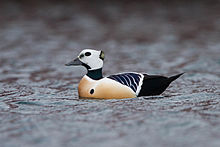Polysticta
| Steller's eider | |
|---|---|
 |
|
| A drake | |
 |
|
| A hen | |
| Scientific classification | |
| Kingdom: | Animalia |
| Phylum: | Chordata |
| Class: | Aves |
| Order: | Anseriformes |
| Family: | Anatidae |
| Subfamily: | Merginae |
| Genus: |
Polysticta Eyton, 1836 |
| Species: | P. stelleri |
| Binomial name | |
|
Polysticta stelleri (Pallas, 1769) |
|
The Steller's eider (Polysticta stelleri) is a smallish sea duck that breeds along the Arctic coasts of eastern Siberia and Alaska.
This species is the smallest eider at 45 cm (18 in) long. The male is unmistakable with his white head marked by a thick black eye ring and greenish-black tufts of feathers on the forehead and the back of the head. Chin, throat and neck are also black, as are the back, tail, and rump. Wings are dark bluish-purple with white edging. When folded, they give a striped appearance across the back. The speculum is metallic blue bordered with white. The breast and flanks are cinnamon-buff marked with a black spot on each side just above the waterline. Legs, feet and bill are dark bluish-grey.
The female is a dark brown bird, smaller with a more typically duck-shaped head and body than other eider species.
The drake's call is a deep crooning, although it is relatively quiet compared to the Somateria eiders. The hen also has a repertoire of grunts and whistles.
The lined nest is built on tundra close to the sea, and 6–10 eggs are laid.
It winters somewhat farther south in the Bering Sea, northern Scandinavia and the Baltic Sea. It can form large flocks of up to 200,000 birds on suitable coastal waters. It is scarce south of its wintering range.
This species dives for crustaceans and molluscs, with mussels being a favoured food.
The genus name is derived from Ancient Greek polustiktos, "much spotted", from polus "many" and stigme "spot". The species name is for German naturalist and explorer Georg Steller.
The Steller's eider is thought to have hybridised with the common eider on at least two occasions in the wild. A drake showing characteristics of both species was present at Cuxhaven, Niedersachsen, Germany, on 17 November 1993. Another drake was seen in Vadso harbour, Varanger, Norway, on 7 April 1995; a photograph of this bird was published accompanying Forsman (1995).
...
Wikipedia

